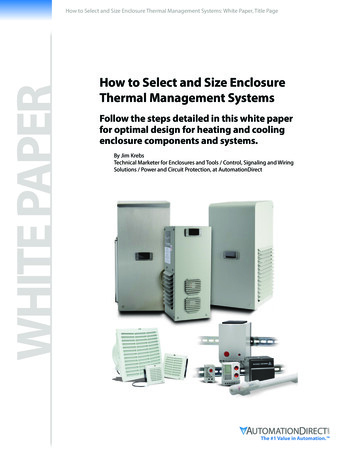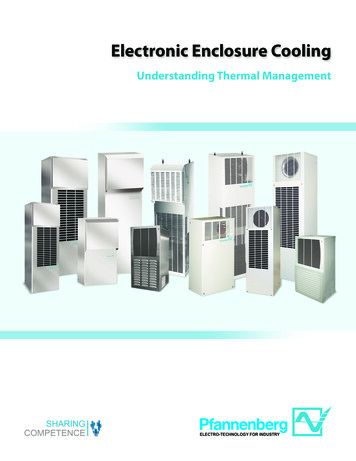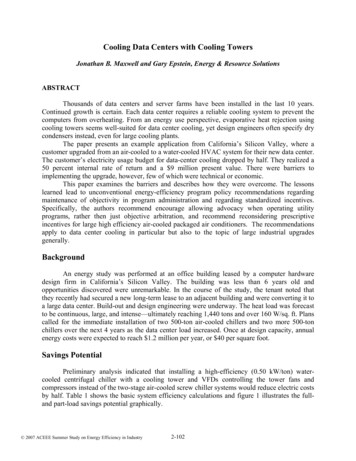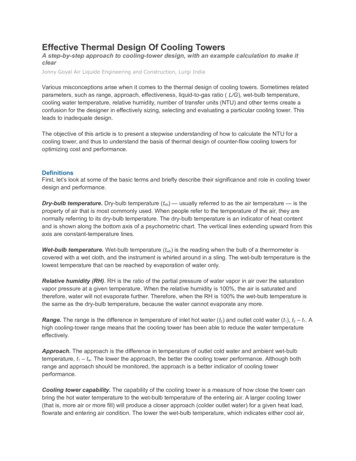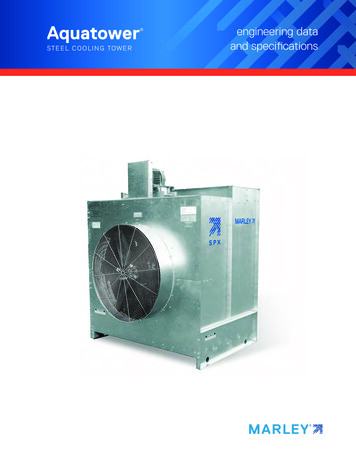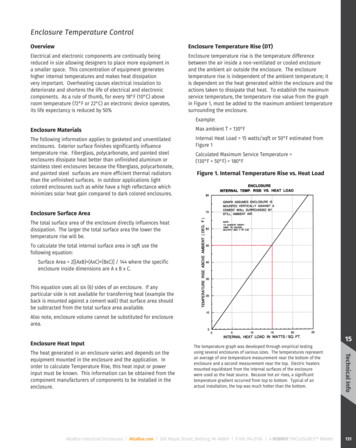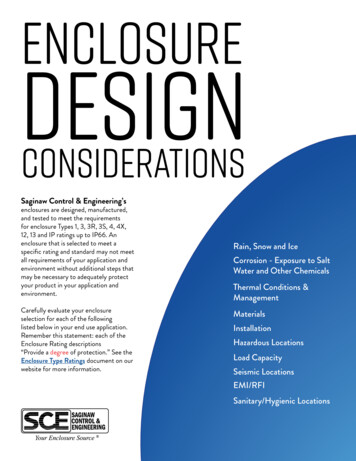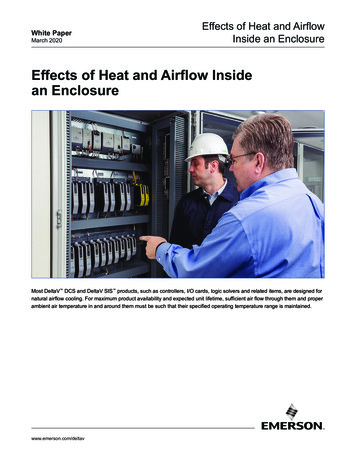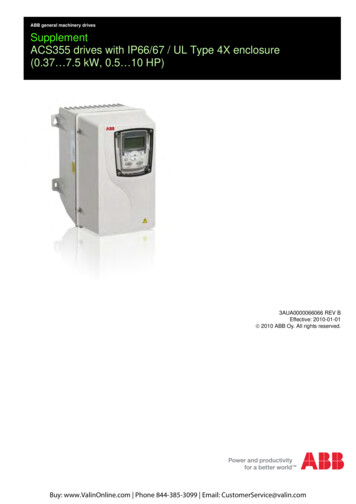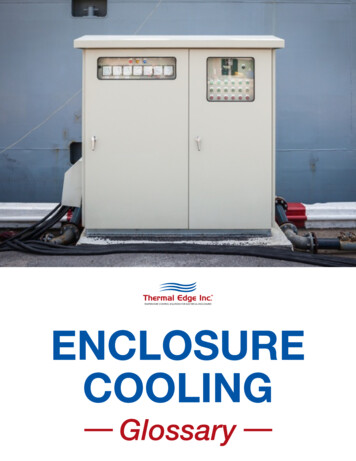
Transcription
ENCLOSURECOOLINGGlossary
ContentsINTRODUCTION . 3TYPES OF COOLING EQUIPMENT . 4COOLING EQUIPMENT COMPONENTS . 5ESSENTIAL COOLING TERMS . 8COOLING EQUIPMENT ACCESSORIES . 13EQUIPMENT THAT NEEDS COOLING . 16IMPORTANT STANDARDS . 17DOCUMENTATION AND CALCULATIONS . 19NEXT STEPS . 20Enclosure Cooling Glossary
Introduction:About This GlossaryThis glossary explains some of the terms that are specifically related to enclosure cooling. Itspurpose is to extend and enhance your knowledge and understanding of enclosure coolingsystems. Hopefully this glossary will remove some of the mystery associated with the subjectand enhance interaction between the users and enclosure cooling manufacturers.The glossary is broken up into seven sections, starting with a short section about the types ofenclosure cooling equipment and followed by a section covering cooling system components.This leads to a long section that explains cooling terms and cooling accessories. The last twosections deal with engineering standards and documentation.In order to avoid confusion, items are only defined once, even though they may logically beincluded in more than one section.Enclosure Cooling Glossary3
Types of CoolingEquipmentThese are the most common types of enclosure cooling equipment.TERMDEFINITIONAir conditionerRefrigeration-based cooling system that uses the thermodynamic properties ofa refrigerant in order to extract heat from an enclosure. Key components of anair conditioner are a compressor, expansion valve, condenser, and evaporator.Air conditioners can cool enclosures to temperatures that are below ambienttemperature. The thermal capacity of standard air conditioners varies between1,000 BTU/H and 20,000 BTU/H. Typical power sources include 110, 230, and 480volts AC and 48 volts DC. Enclosure air conditioners operate on a closed-loopcooling cycle.Air to air heatexchangerThis is an enclosure cooler that works by circulating hot air from the enclosure overa heat-conductive heat pipe. This in turn discharges the heat to the outside air. Aheat exchanger uses no external power for the cooling process and is extremelyefficient. The heat exchanger relies on a thermal gradient, so its only limitation isthat it cannot cool below ambient air temperature. An air to air heat exchangeroperates on a closed-loop cooling cycle.Enclosure andair conditionerpackageFiltered fanpackageEnclosure Cooling GlossaryAn electrical enclosure supplied as a kit with an enclosure air conditioner. Theenclosure features cutouts required for a designated air conditioner model.An enclosure cooling fan designed to remove heat from an electrical enclosure. Thepackage supplied includes a fan with inlet filter and an exhaust vent with filter. Fansremove heat; they do not cool an enclosure. They draw outside air into the bottomof the enclosure and discharge it at the top. Fans operate on an open-loop coolingcycle.4
Cooling EquipmentComponentsThis section describes the major components that are used inenclosure cooling equipment and how they work.TERMDEFINITIONAir filterA device manufactured from a porous material designed to trap dust, debris and oilin the air while causing minimal airflow restriction.BlowerA mechanical device for moving air, consisting of a motor that is fitted with rotatingimpellers in a “squirrel-cage” ive compressor safeguards, including high- and low-pressure cutoutsand short-cycle protection.CondensateWater that condenses from the air as it is chilled by the air conditioner’s evaporatorcoil. Condensate must be collected and removed.CondensateevaporationsystemA method of removing the condensate collected by the air conditioner evaporator.It uses the heat from the compressor’s hot gas line in order to evaporate the water,which is then discharged as vapor to the ambient air. Condensate evaporationavoids the need for messy condensate drains and has the added benefit ofreducing the hot gas’s temperature, increasing system efficiency. This method isunique to Thermal Edge enclosure air conditioners.Condenser coilEnclosure Cooling GlossaryAn air-cooled device that is used in order to concentrate hot, pressurized refrigerantgas into a liquid. As the gas cools, it gives off heat to the ambient air.5
Cooling Equipment Components (cont.)TERMDEFINITIONCompressorA rotary, positive displacement pump used in order to compress refrigerant gas sothat it can be condensed into refrigerant liquid. Modern refrigerant compressorsincorporate many design features that increase the overall efficiency of airconditioners.DigitaltemperaturecontrollerAn electronic mechanism fitted to an enclosure air conditioner and used in order tocontrol the enclosure temperature around a user-defined set point. The controllerhas several additional functions that include high-temperature alarms, high- andlow-pressure alarms, and compressor anti-short cycle function. It is able tocommunicate with remote-control and monitoring devices using various protocols.Evaporator coilA device inside the air conditioner through which a mixture of refrigerant liquid andexpanding refrigerant vapor passes. As the liquid vaporizes, it absorbs heat, andthis cools the evaporator coil , and cooling the air going into the enclosure.Heat pipeHightemperaturealarmMountingoptionsEnclosure Cooling GlossaryThis is the heart of the air to air heat exchanger. It is a vertical tube fitted withaluminum fins in order to aid heat transfer. It is partially evacuated and filled witha suitable refrigerant. The refrigerant is chosen so that it boils when hot air fromthe enclosure is passed over it. As the refrigerant boils, it absorbs heat from theenclosure. The refrigerant vapor rises to the top of the pipe, where it is cooled byambient air that is blown over the tube. This vapor condenses back into liquid,giving up its heat to the ambient air.An adjustable alert mechanism connected to a set of dry contacts actuated by thedigital controller that provides a warning if the enclosure temperature goes too high.Enclosure air conditioners and air to air heat exchangers are primarily designedto be mounted on either side of an electrical enclosure. Optionally, they can bemounted on the enclosure door, provided it is strong enough and the enclosureis anchored down. Air conditioners are also available to mount on the top of anelectrical enclosure.6
Cooling Equipment Components (cont.)TERMPower cordDEFINITIONPower supply wiring connected to enclosure coolers and fans that is fitted with asuitable plug.Power switchAn on/off power control fitted to enclosure coolers to energize the unit.Refrigerant: A substance that absorbs heat in order to form a vapor. Whencompressed, it condenses and gives up that heat.Rigid chassisAir conditioners and air to air heat exchangers with a rigid chassis provide theability to be serviced without being removed from an electrical enclosure.Sloped topThe top surface of air conditioner shrouds is sloped in order to allow easy waterrunoff.ThermalexpansionvalveA special flow controller that regulates the circulation of refrigerant liquid to the airconditioner evaporator. It operates by sensing the temperature of the refrigerantas it expands, and this allows it to control the flow of refrigerant in order to suit theheat load. A thermal expansion valve is the most efficient method of controlling theexpansion of a refrigerant and can tolerate a wide heat load range.Enclosure Cooling Glossary7
EssentialCooling TermsThis list comprises commonly used terms related to enclosure cooling.TERMACAmbienttemperatureBackup powerBTU/HCapillary tubeCFMClosed-loopcoolingEnclosure Cooling GlossaryDEFINITIONAlternating electric current.The temperature of the outside air around an enclosure.Battery-operated backup power often used to provide power totelecommunications equipment during power outages.A unit of measurement of thermal energy known as British Thermal Units per Hour.One BTU/H is equivalent to 0.29 watts.A long, small-diameter copper pipe used in order to control the expansion of arefrigerant. It performs the same function as a thermal expansion valve, althoughit is calibrated for only one temperature. It’s commonly used on domesticrefrigerators.An abbreviation for Cubic Feet per Minute; it’s used as a measure of the flow of air.A term used in order to describe a cooling solution in which the enclosure iscompletely sealed, preventing the entry of outside air. This stops contaminants fromentering the enclosure and is the only practical method for cooling enclosures byenclosure air conditioning, because it avoids the uncontrolled flow of hot outside airinto the enclosure.8
Essential Cooling Terms (cont.)TERMDEFINITIONCompressorprotectionA self-resetting thermal overload switch mounted to a refrigeration compressor.ConductionThe transfer of heat through a solid object.ConvectionThe transfer of heat energy using a fluid such as air or water.CoolingcapacityDCDehumidificationDew pointDirt and dustThe thermal cooling ability of an enclosure cooler measured in BTU/H or in watts.Direct electric current.The removal of water vapor from the air, usually achieved by cooling the air to atemperature below the dew point, causing the moisture to condense.The temperature at which water vapor in the air will condense. The dew-pointtemperature is directly related to the relative humidity of the air.Small particles in the air composed of earth, soil, or waste matter.EfficiencyThe ratio between the input power to a machine or electronic device and the usableoutput power.ElectricalenclosureA special cabinet that has been designed for the installation of electrical controlgear and that complies with certain safety standards.Enclosure Cooling Glossary9
Essential Cooling Terms sFan-cooledHeat loadDEFINITIONThe measure of warmth or coldness of the air inside an enclosure.The condition of the air around an enclosure, including its temperature and relativehumidity as well as the amount of dirt and dust particles in the air. The term alsoencompasses exposure to the sun and the presence of corrosive substances, rain,and snow.Equipment cooled by the forced circulation of air using a fan.The amount of heat generated by the equipment inside an enclosure.Heat transferThe exchange of thermal energy between physical systems.High altitudeThe effectiveness of an air conditioner decreases with altitude in direct proportionto the density of air. At 3,000 feet, the capacity of an air conditioner is reduced by10 percent.Hot gas lineThe refrigerant tubing that carries hot, compressed gas away from the compressor.Hot spotsAreas within an electrical enclosure that are hotter than others due to poor airflowor local sources of heat.InsulatedenclosureAn enclosure fitted with thermal lining material that reduces heat transfer throughthe walls on the enclosure.Latent heatEnclosure Cooling GlossaryThe energy required in order to change the state of a substance, such as the energyrequired to convert water at 212 F into steam without changing its temperature.10
Essential Cooling Terms (cont.)TERMDEFINITIONMaximumambienttemperatureThe highest temperature that has been recorded for a particular location.MinimumambienttemperatureThe lowest temperature that has been recorded for a particular location.NaturalventilationThe natural flow of air through an enclosure, aided by the natural tendency of hot airto rise.Open-loopcoolingA cooling solution that draws cooler outside air into an enclosure in order to coolequipment. It is the opposite of closed-loop cooling.PowerThe rate at which energy is released or used. It is measured in horsepower or watts.One horsepower is equal to 746 watts.RadiationThe transfer of heat energy through electromagnetic rays. The heating effect of thesun is an example of radiation.RefrigerationcycleA closed cycle of the evaporation, compression, and condensation of a refrigerantthat transfers heat from one place to another.RelativehumidityThe amount of water vapor present in the air compared to the maximum amount ofwater that the air can hold at that temperature.Solar heat loadEnclosure Cooling GlossaryThe heating effect of the sun’s radiation on an enclosure.11
Essential Cooling Terms (cont.)TERMTelecomenclosureDEFINITIONA special cabinet that houses telecommunications equipment.TemperatureThe measurement of heat energy in a body or substance. It is usually measured indegrees Fahrenheit, although the metric measures of centigrade and Celsius arealso common.TemperaturecontrolThe use of a controller in order to regulate the temperature of an enclosure arounda set temperature.ThermostatVentilatedWatts per FEnclosure Cooling GlossaryA device used in order to regulate temperature by opening or closing a switch asthe temperature around the sensor changes.Equipment that is cooled by the flow of external air through the enclosure.A measure of the cooling capacity of an air to air heat exchanger that providesinformation on the amount of heat in watts that will be removed for each degreeFahrenheit of difference between the enclosure temperature and the outsideambient temperature. This term can also be stated as watts per C.12
Cooling EquipmentAccessoriesThis section covers those items that are generally available as optional accessories.TERMDEFINITIONAl
Enclosure Cooling Glossary 9 A self-resetting thermal overload switch mounted to a refrigeration compressor. The transfer of heat through a solid object. The transfer of heat energy using a fluid such as air or water. The thermal cooling ability of an enclosure


